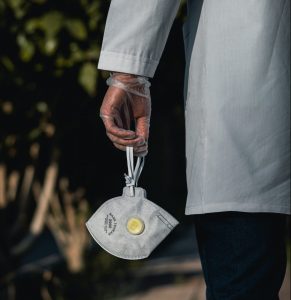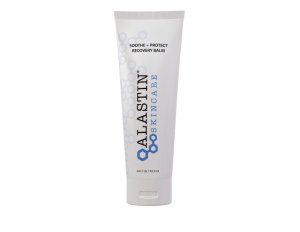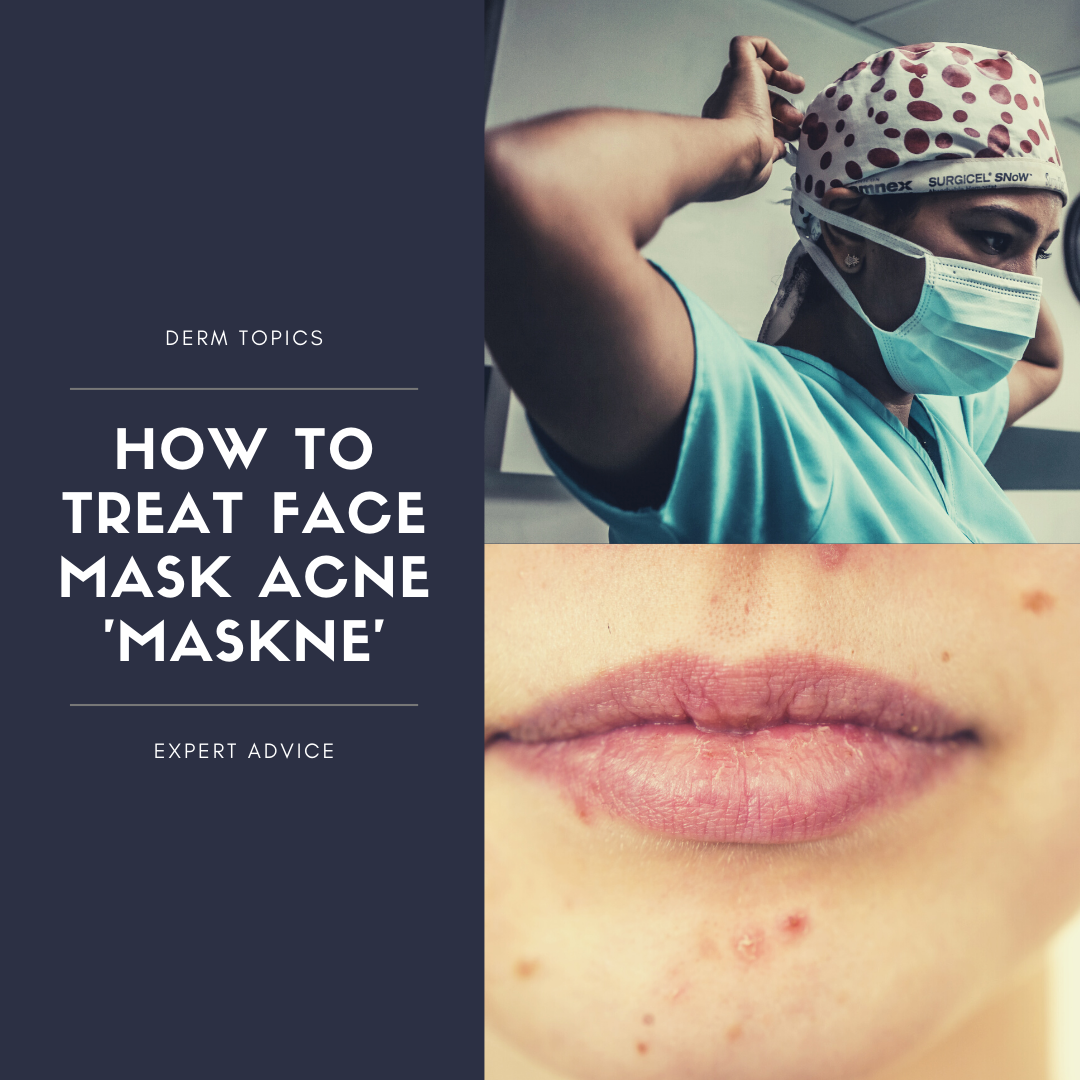Not all superheroes wear capes. But in this case, they all wear masks. Whether you’re an essential worker donning the mask for hours and hours (thank you!) or masking-up before a trip to the grocery store, you’re helping to protect your community and your health by wearing face coverings.
But when the mask comes off, you may have noticed some new facial foes: blemishes, skin irritation, peeling, or redness around your jawline, cheeks, and mouth.
Those irritations in fact have become so common that mask acne has now been dubbed maskne.
To defeat this enemy, we talked to Dr. Nazanin Saedi, Director of Jefferson Laser Surgery and Cosmetic Center in Philadelphia, Pennsylvania. Read on to learn about face mask acne and other mask skin irritations, their cause, treatment, and preventative measures you can take every day.
What is ‘Maskne?’
Maskne is acne breakouts along the jaw, cheeks, and mouth caused by wearing a face mask—get it? Mask, acne, maskne!
Typically, acne occurs when pores become clogged by sweat, oil, moisture, or dirt. These elements trap bacteria beneath the skin’s barrier, creating a pimple.
The difference between acne and maskne is one thing: a face mask.
“We are seeing irritation and acne more on the face with people wearing masks for an extended period of time,” Dr. Saedi told ALASTIN. “You can see breakouts in the areas covered by the mask and also the areas where the mask and face shields touch the skin.”
So how does the mask play into maskne?
Here are just a few ways masks can cause acne from a face mask:
-
- Moisture – When confined beneath the fabric of a mask, your breath creates a humid environment. And according to Dr. Saedi, humidity is the enemy of clear skin. “Breathing for hours with a mask on creates humidity. That humidity becomes a breeding ground for acne.”
- Moisture – When confined beneath the fabric of a mask, your breath creates a humid environment. And according to Dr. Saedi, humidity is the enemy of clear skin. “Breathing for hours with a mask on creates humidity. That humidity becomes a breeding ground for acne.”
-
- Bacteria – Sweat, oil, and makeup can become trapped under the mask and clog pores. And bacteria is constantly being reintroduced into your skin thanks to your hands. Every time you adjust your mask or even just put it on, you’re introducing pore-clogging oil and dirt into your pores from your hands. Those clogged pores can result in—you guessed it —acne.
-
- Friction – As you go about your day, your mask moves around your face, damaging the skin’s protective layer, sometimes called the “skin barrier.” And without that protective barrier, it’s easier for bacteria and grime to settle into your pores and make pimple babies.
-
- Warm weather – Heat and humidity can exacerbate acne, inside and outside the mask. Higher temperatures increase your face’s sweat and oil protection. And the more oil and sweat, the easier it is for bacteria to turn into blemishes.
-
- Cold weather – Your mask can make maskne in heat or sleet. Cold weather can dry out your skin, making it easier for the mask to chafe the skin and break down and welcome pimple-causing irritants into your pores.
- Cold weather – Your mask can make maskne in heat or sleet. Cold weather can dry out your skin, making it easier for the mask to chafe the skin and break down and welcome pimple-causing irritants into your pores.
No matter how you’re using your mask, maskne will probably be a consistent issue in the future. And left untreated, things could only get worse.
“If mask-caused acne is not treated, it can lead to more acne but also the irritation can cause more of a breakdown in the skin barrier,” says Dr. Saedi.
But thanks to experts like Dr. Saedi, we have a maskne solution for mask-wearing heroes everywhere.
How to Prevent Maskne
 Whether you’re wearing a surgical mask, disposable mask, or washable mask for double-shifts at your essential job or for a long morning run, (or as you fight crime in Gotham City), there are ways you can prevent maskne.
Whether you’re wearing a surgical mask, disposable mask, or washable mask for double-shifts at your essential job or for a long morning run, (or as you fight crime in Gotham City), there are ways you can prevent maskne.
An Acne-Fighting Skin Care Routine
Wearing your mask helps shield you against health concerns. And like wearing your mask, fortifying skin care practices can protect your skin from maskne.
Try incorporating these rituals into your skincare routine:
-
- Cleanse your face regularly – Washing your face morning and night can prevent the build up of bacteria, oil, and other pore-clogging elements. But stay clear of the super-drying acne face washes—after hours of rubbing and chafing, your skin needs a gentler formula to keep the skin barrier intact.
So repeat after us: A gentle cleanser twice a day keeps the maskne away.
But which product can directly support the issues caused by maskne? “I recommend using a gentle cleanser such as ALASTIN’s Gentle Cleanser,” Dr. Saedi says.
ALASTIN’s Gentle Cleanser can cleanse impurities, environmental pollutants, and makeup from the skin without causing irritation. This formula’s inflammation-calming antioxidants also help reduce redness in blemishes.
-
- Stay clear of drying products – When it comes to protecting your skin from irritations, supporting the skin barrier is essential. But drying products can make your skin more vulnerable to bacteria. That means taking a good look at your medicine cabinet and saying, “Hey, I think we need to take a break” to some of your products.
“People might be overdoing it at home with face masks, scrubs, washes, and toners,” says Dr. Saedi. “Overdoing it will compromise the barrier.”
Simplify your skin care routine and focus on calming, nourishing products instead. Check out our guide on skin care routine order.
-
- Use moisturizer – We know what you might be thinking. “WHAT? You just spent half of this article telling me that oil and moisture cause maskne and now you’re telling me to moisturize? What’s going on here?”
- Use moisturizer – We know what you might be thinking. “WHAT? You just spent half of this article telling me that oil and moisture cause maskne and now you’re telling me to moisturize? What’s going on here?”
Just ask the good doc:
“I also recommend moisturizing the skin regularly. Many people with acne or redness are hesitant to moisturize and think that will break out more. If you have dry skin, then you have compromised the skin barrier and will be more prone to breaking out and having sensitive skin irritation.”
Thanks Dr. Saedi!
Using a light, nightly moisturizer helps to strengthen the skin barrier, preventing skin irritation from the mask.
-
- Hold off on makeup – Without your mask, your makeup is flawless, tasteful, and a great boost to your confidence. Your foundation, blush, lipstick, and other formulas can mix with sweat, oil, and condensation from your breath to make a heady pore-clogging environment under your mask. Take a break from makeup on the lower half of your face. But feel free to go to town on your eye shadow and mascara!
- Hold off on makeup – Without your mask, your makeup is flawless, tasteful, and a great boost to your confidence. Your foundation, blush, lipstick, and other formulas can mix with sweat, oil, and condensation from your breath to make a heady pore-clogging environment under your mask. Take a break from makeup on the lower half of your face. But feel free to go to town on your eye shadow and mascara!
-
- Hand hygiene – If you haven’t been washing your hands… well, you really need to be washing your hands.
 The oils and microscopic grime of your hands can introduce irritants to your face. Wash your hands frequently with lukewarm water and soap.
The oils and microscopic grime of your hands can introduce irritants to your face. Wash your hands frequently with lukewarm water and soap.
- Hand hygiene – If you haven’t been washing your hands… well, you really need to be washing your hands.
Smart Mask Practices
How you manage your mask can help amplify the effects of your skincare treatment. Take a look at these smart mask practices to help reduce maskne:
-
- Find the right mask – While most masks are “One Size Fits All,” certain masks do a better job of protecting you from maskne.
All you need is a mask with the following qualities:
- Find the right mask – While most masks are “One Size Fits All,” certain masks do a better job of protecting you from maskne.
-
-
- A comfortable fit (not too tight)
-
-
-
- Light, breathable fabric like cotton or a cotton blend
- Light, breathable fabric like cotton or a cotton blend
-
-
- Proper mask wear – Every minute you wear your mask, it absorbs bacteria from your mouth, sweat, and oil like a face sponge of yuckiness. So from now on, treat your mask like you (hopefully) treat your underwear—one wear per day.
- Proper mask wear – Every minute you wear your mask, it absorbs bacteria from your mouth, sweat, and oil like a face sponge of yuckiness. So from now on, treat your mask like you (hopefully) treat your underwear—one wear per day.
-
- Mask hygiene – Wash your mask between uses with detergent, hot water, and a bit of white vinegar—white vinegar is known for its antibacterial, anti-viral, and antifungal properties.
- Mask hygiene – Wash your mask between uses with detergent, hot water, and a bit of white vinegar—white vinegar is known for its antibacterial, anti-viral, and antifungal properties.
Which Mask is Best for Acne-Prone Skin?
If you have acne-prone skin, you may need a special mask to help prevent breakouts. According to scientists, silk or silk-lined masks have antimicrobial properties and are gentle on your skin.
Plus, you’ll feel so fancy.
But if silk is scarce, you can’t go wrong with a cotton mask. The light, breathable fabric will let air circulate easier in your mask and help reduce sweat and oil production.
Is It Okay to Put On A Face Mask When You Have Pimples?
Yes, just be sure to protect your skin as much as you can from the rubbing and irritations of a mask.
For dealing with irritations and a mask, Dr. Saedi has the solution, “I recommend ALASTIN’s Soothe + Protect Recovery Balm for areas where there is a breakdown in the skin.”
This unique formula supports the body’s natural renewal properties, fortifies the skin barrier, calms redness, and helps keep the skin hydrated.
How to Treat Mask Acne
Now that you know how to prevent maskne, you may be wondering, “Well, what am I supposed to do with the maskne I have now? I have a battle with the Joker later and I don’t want to look ridiculous!”
There are multiple maskne treatments to try, here are just a few:
-
- Exfoliate and moisturize – Use a gentle exfoliant and hydrator to help clear away the smaller particles that hang out on your face and clog your pores. But remember what Dr. Saedi said about “overdoing it” with the face stuff! A once a week exfoliation and hydration treatment is all you need to help your mask acne.
-
- Spot treatments – Focused spot treatments can help zap acne and reveal clear, shining skin. Look for spot treatments with one or more of these ingredients:
- Spot treatments – Focused spot treatments can help zap acne and reveal clear, shining skin. Look for spot treatments with one or more of these ingredients:
-
-
- Salicylic acid
- Sulfur
- Zinc
- 2.5% benzoyl peroxide
-
Acne spot treatments tend to be very drying. Use them gradually to help blast blemishes and prevent future pimples.
-
- ALASTIN Nectar – ALASTIN’s Regenerating Skin Nectar with TriHex Technology® formula calms and supports the skin. Dr. Saedi says, “I have been recommending ALASTIN Nectar because of the anti-inflammatory effects but also the Trihex Technology® helps increase collagen and elastin production to build healthy skin. ALASTIN Nectar has been helpful to minimize irritation.”
By supporting the building blocks of skin health and treating inflammation, ALASTIN Regenerating Skin Nectar can be your secret weapon in the fight against maskne.
- ALASTIN Nectar – ALASTIN’s Regenerating Skin Nectar with TriHex Technology® formula calms and supports the skin. Dr. Saedi says, “I have been recommending ALASTIN Nectar because of the anti-inflammatory effects but also the Trihex Technology® helps increase collagen and elastin production to build healthy skin. ALASTIN Nectar has been helpful to minimize irritation.”
ALASTIN’s Anti-Maskne Essentials
You’re now thoroughly educated on the in’s and out’s of maskne. But when it comes to fighting the villainous maskne and supporting long-term skin health, stock your medicine cabinet (or utility belt) with the best—ALASTIN.
ALASTIN’s Chief Medical Officer, Dr. Alan Widgerow has seen some incredible results from ALASTIN’s formulas when it comes to mask-caused skin irritants: “Overall, these ALASTIN products facilitate the body’s capacity to heal by providing an ideal micro-environment in which to do that.”
Here’s a quick list of ALASTIN’s maskne essentials and how to use them.
-
- Gentle Cleanser – Gently cleanse your skin of irritants with ALASTIN’s sulfate-free and antioxidant-packed face wash. Use it in the morning and at night.
- Gentle Cleanser – Gently cleanse your skin of irritants with ALASTIN’s sulfate-free and antioxidant-packed face wash. Use it in the morning and at night.
-
- Restorative Skin Complex – Hydrating and nourishing, ALASTIN’s Restorative Skin Complex with TriHex Technology® acts as a super-powered daily moisturizing serum to reduce mask irritation. According to Dr. Saedi, “The ceramides in the Restorative Skin Complex helps strengthen the skin barrier.”
- Restorative Skin Complex – Hydrating and nourishing, ALASTIN’s Restorative Skin Complex with TriHex Technology® acts as a super-powered daily moisturizing serum to reduce mask irritation. According to Dr. Saedi, “The ceramides in the Restorative Skin Complex helps strengthen the skin barrier.”
-
- Regenerating Skin Nectar – “Apply ALASTIN Skin Nectar twice a day to help minimize irritation,” Dr. Saedi instructs. “Personally, I think it helps with calming down inflammation and reduces post-inflammatory hyperpigmentation.”
-
- Soothe + Protect Recovery Balm –
 This balm tops it all off with soothing and rejuvenating goodness. The Soothe + Protect Recovery Balm helps nourish the skin’s barrier and promotes healthy regrowth of skin cells. It also works incredibly well with ALASTIN’s Skin Nectar.
This balm tops it all off with soothing and rejuvenating goodness. The Soothe + Protect Recovery Balm helps nourish the skin’s barrier and promotes healthy regrowth of skin cells. It also works incredibly well with ALASTIN’s Skin Nectar.
- Soothe + Protect Recovery Balm –
This superheroic skin care team can do wonders for your skin. Dr. Widgegrow saw the results himself on health care workers using the formulas to nourish and protect their skin from mask-related skin issues:
“It is not surprising to me that reports are filtering through about the tremendous relief experienced with the use of ALASTIN’s Regenerating Skin Nectar and Soothe + Protect Balm in health care workers following the protracted use of masks. The combination of potent anti-inflammatory components and positive healing factors ensure that not only symptoms improve but in the case of any superficial breaches of the skin, these heal optimally too.”
All-Encompassing Skin Health
You’ve been wearing your face mask to protect yourself and others. You’re a hero. With ALASTIN, you can protect your skin as well as your health. Because in times like these, your skin deserves love and care. But most importantly, so do you. For that, we’re here to help.
Check out our nourishing and restorative formulas today every skin type on alastin.com!
Sources:
Mayo Clinic. Acne. www.mayoclinic.org/diseases-conditions/acne/symptoms-causes/syc-20368047
Shape. Dermatologist Explain Everything You Need to Know About ‘Maskne’. https://www.shape.com/lifestyle/beauty-style/maskne-face-mask-acne-mechanica
The Washington Post. Wearing a mask can irritate your face or make it break out. Here’s what to do about ‘maskne.’ https://www.washingtonpost.com/lifestyle/wellness/face-mask-acne-breakout-coronavirus/2020/06/03/57ed3d84-a4ea-11ea-b619-3f9133bbb482_story.html
ACS Publications. Aerosol Filtration Efficiency of Common Fabrics Used in Respiratory Cloth Masks. https://pubs.acs.org/doi/abs/10.1021/acsnano.0c03252
This article was published as a part of a series of educational initiatives on safely reopening dermatology practices, “Best Practices and Practical Pearls for Safely Reopening Derm Practices”. Support for the project was received in part from Alastin. The content for this article was written and provided by Alastin.
Did you enjoy this article? Find more on Medical Derm topics here.

